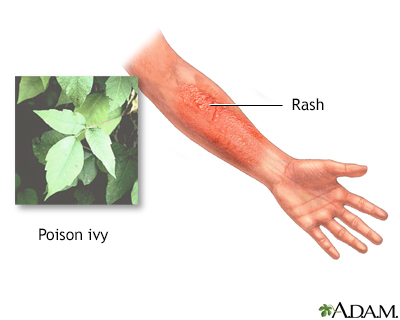| Poison ivy - poison oak - poison sumac |
Contact with poison ivy is one of the most frequent causes of skin rash in children during the spring, summer, and fall seasons. The resins of these plants, called urushiol, cause an allergic reaction in more than 50% of the population. Exposure to the smoke of these burning plants can cause the same reaction.

Poison ivy can be found in every region of the United States except the Southwest, Alaska, and Hawaii. It appears as a weed with three shiny green leaves and a red stem. The plant grows in the form of a vine, often along riverbanks.
Poison oak is primarily found on the West Coast. It grows in the form of a shrub and has three leaves similar to poison ivy.
Poison sumac grows abundantly along the Mississippi River, but is far less common in other regions. It grows as a shrub. Each stem contains 7 - 13 leaves arranged in pairs.

Causes
Dermatitis is caused by a sensitivity to the resin of these plants. The rash is spread by the oils touching various parts of the body. It is not spread by the fluid of the blisters it creates, thus it is not contagious unless the resin remains on the skin and is touched by another person.
However, the oily resin usually enters the skin rapidly, and is seldom transferred person to person. Conversely, the resin may persist for long periods on contaminated clothing, pets, tools, etc., and sensitive individuals can easily develop the rash from delayed contact with contaminated items.
This is a true allergy. Most people will have no reaction the first time they are exposed. In fact, children under the age of 7 are rarely sensitive. Sensitivity is particularly rare under the age of one, and when infants do break out, the rash is usually mild.
Symptoms
- Redness and extreme itching are the first signs.
- Rash erupts on areas exposed to the resin, and it is often in the pattern of streaks or patches consistent with where the plant touched the skin.
- Rash is in the form of red bumps (papules) and may also form large, weeping blisters.
- Worst stage of the rash is experienced 4 - 7 days after exposure.
- Rash may last for 1 - 3 weeks.
Symptoms do not appear immediately. You will notice them within 2 days of exposure, and rarely as late as 2 weeks later. Reactions can vary from mild in some individuals to very severe in highly sensitive individuals. Hospitalization is sometimes required.
First aid
- The skin should be washed thoroughly with cold (not warm) water only as soon as possible following exposure. Next, liberally apply rubbing (isopropyl) alcohol, if available, to the affected area. Rubbing alcohol helps remove the plant oils and prevents spreading. Soap is less effective, but may help if rubbing alcohol is not available. Because the resin enters skin quickly, it should be washed off completely within 30 minutes to prevent a reaction.
- Camping stores sell products that bind the resins, and which may be more effective at removing the resins from your body.
- Scrub under the fingernails with a brush to prevent spreading of the resin to other parts of the body by touching or scratching.
- Wash the clothing and shoes of the exposed person with soap and hot water. Resin can linger on these surfaces for days.
- Bathe animals that may have been exposed and can carry the resin on their fur.
- Body heat and sweating can aggravate itching. Keep the victim cool and apply cool compresses to the skin.
- Calamine lotion and topical hydrocortisone cream may be applied to the skin to help decrease itching and blistering.
- Antihistamines, such as Benadryl (diphenhydramine) help relieve itching and can be mildly sedating. Bathing in tepid water with one cup of Aveeno oatmeal per tub may also soothe itchy skin. Aluminum acetate (Domeboro solution) soaks can also be helpful to dry the rash and reduce itch.
- In cases of severe or extensive rash, especially around the face or genitals, your physician may prescribe oral or injected steroids.
Do not...
- DO NOT touch the skin or clothing of the exposed person with your bare hands, if possible, until after they have been thoroughly washed.
- DO NOT burn poison ivy, oak, or sumac to get rid of it. The resins can be spread via smoke, and can cause severe exposures to individuals far downwind.
Call immediately for emergency medical assistance if...
- The victim is suffering a severe allergic reaction, such as swelling and/or difficulty breathing, or has had a severe reaction to a past exposure.
- The victim has been exposed to the smoke of a burning plant.
- The rash covers more than one quarter of the body.
Call your physician if...
- Itching is severe and cannot be controlled.
- The rash affects the face, lips, eyes, or genitals.
- The rash shows signs of infection, such as pus, yellow fluid leaking from blisters, odor, or increased tenderness.
Prevention
- Learn to identify poison ivy, oak, and sumac, and teach your children to identify them as soon as they are able.
- Remove these plants if they grow near your home (but never burn them).
- Cover skin with clothing (long sleeves, long pants, shoes, and socks) when walking in the woods or in areas where these plants may grow.
- Be aware of resins carried by pets.
- Barrier creams, such as Ivy-Block, may offer some protection.
Reviewed By: Paula J. Busse, MD, Assistant Professor of Medicine, Division of Clinical Immunology, Mount Sinai School of Medicine, New York, NY, Review provided by VeriMed Healthcare Network. Also reviewed by David Zieve, MD, MHA, Medical Director, A.D.A.M., Inc.
